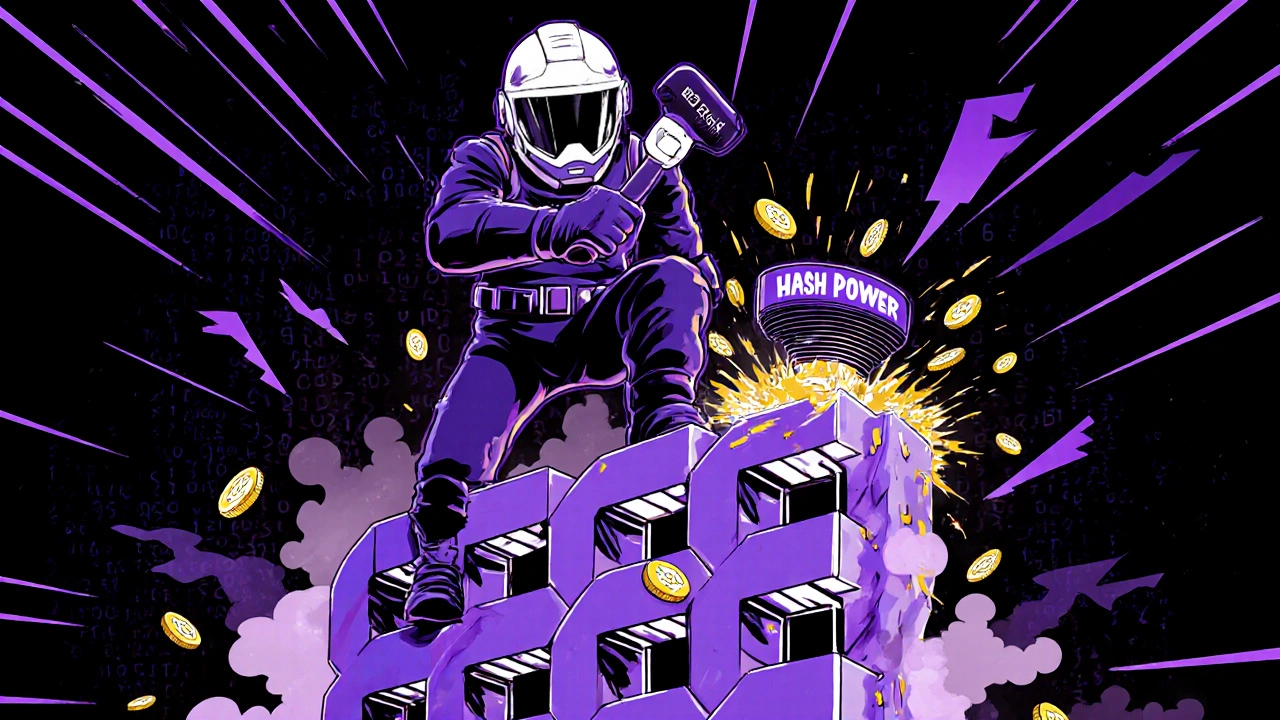What Exactly Is a 51% Attack?
A 51% attack happens when one person or group controls more than half of a blockchain’s mining power. This isn’t just a theoretical risk-it’s a real vulnerability that’s been exploited multiple times on smaller cryptocurrencies. The attack doesn’t let the attacker steal coins from other people’s wallets or create new money out of thin air. What it does allow is rewriting recent transaction history, stopping new transactions from confirming, and double-spending their own coins. Think of it like having a secret copy of the ledger that you can secretly update and then suddenly show everyone as the "real" version.
How Does It Actually Work?
Blockchains like Bitcoin use Proof-of-Work (PoW) to agree on which transactions are valid. Miners compete to solve complex math problems, and the first to solve it gets to add the next block. The network always follows the longest chain-the one with the most cumulative work. If you control over 50% of the total mining power, you can secretly mine a longer chain in private while the rest of the network keeps building on the public chain. Once your secret chain is longer, you broadcast it. The network switches to it automatically, and any transactions on the old chain that conflict with yours get erased.
Here’s the catch: you can only reverse transactions you made yourself. You can’t change who owns what, alter smart contracts, or force people to send you money. But you can spend your coins on an exchange, wait for them to be confirmed, then undo that transaction on your private chain and spend the same coins again. That’s double-spending-and it’s how attackers have stolen millions.
Why Is It Hard to Do on Bitcoin?
Bitcoin’s network hash rate is around 600 exahashes per second (EH/s) as of late 2023. To launch a 51% attack, you’d need to control over 300 EH/s. Renting that much computing power from services like NiceHash would cost more than $1.4 million per hour. Meanwhile, Bitcoin’s market value is over $570 billion. Even if you pulled off a $50 million double-spend, you’d lose over $100 million in rental fees. It’s like trying to rob a bank by hiring 10,000 security guards to distract everyone-except the guards cost more than the cash you’re stealing.
Bitcoin’s security isn’t magic-it’s economics. The bigger the network, the more expensive it becomes to attack. That’s why Bitcoin has never suffered a successful 51% attack in over 14 years. The cost simply doesn’t make sense.
Where Has It Actually Happened?
Smaller blockchains are a different story. In May 2018, Bitcoin Gold (BTG) lost $18 million after attackers rented enough hash power to reverse transactions and steal coins from exchanges. Ethereum Classic (ETC) was hit three times: in January 2019, September 2020, and August 2022. Each time, attackers double-spent millions of ETC. The August 2022 attack cost just $180,000 to rent the hash power-but netted $7.5 million in stolen coins after manipulating prices on exchanges during the chaos.
MIT’s Digital Currency Initiative tracked over 140 confirmed 51% attacks between 2019 and 2023. Nearly 90% of them targeted networks with market caps under $200 million. Vertcoin, a smaller PoW coin, was attacked 12 times between 2018 and 2022. These aren’t random glitches-they’re predictable outcomes of low security budgets.

What Can You Actually Do With a 51% Attack?
Let’s be clear: the damage is limited. You can’t:
- Steal coins from wallets you don’t control
- Create new coins out of nowhere
- Change the rules of the blockchain (like reducing supply or altering block time)
- Modify past transactions beyond a few blocks deep
But you can:
- Reverse your own transactions (double-spend)
- Block specific transactions from being confirmed
- Reorganize the chain to exclude certain addresses or transactions
The real danger isn’t theft-it’s trust erosion. When users see their deposits disappear after a chain reorg, they lose faith in the network. Exchanges start requiring 60+ confirmations instead of 6. Users move to other chains. Developers abandon the project. That’s what killed several smaller PoW coins after repeated attacks.
Why Proof-of-Stake Doesn’t Have This Problem
Ethereum switched from Proof-of-Work to Proof-of-Stake in September 2022. In PoS, instead of miners competing with hardware, validators lock up ("stake") their own ETH to participate. To control 51% of the network, you’d need to buy and lock up over 13.5 million ETH-worth about $13.5 billion as of late 2023. You can’t rent that much ETH like you can rent hash power. And if you tried to attack, the network would slash your staked ETH as punishment. PoS replaces brute force with financial risk.
Other PoS chains like Cardano, Solana, and Polkadot are similarly immune to 51% attacks. But they have their own risks: centralization of staking pools, validator collusion, and governance manipulation. The trade-off isn’t perfect-it’s just different.
How Are Networks Fighting Back?
Some smaller chains are trying to harden themselves. Ethereum Classic is planning a hard fork called Thanos (Q1 2024) that will make mining harder and more expensive, raising the cost of future attacks. Others use checkpointing-where trusted nodes freeze certain blocks so they can’t be reorganized. Namecoin uses merged mining, letting miners secure both Bitcoin and Namecoin at the same time, boosting its effective hash rate.
Exchanges have also adapted. Kraken and other major platforms now require 60+ confirmations for deposits on vulnerable altcoins. That means instead of waiting 60 minutes for Bitcoin, you wait 10 hours. It’s slow, but it prevents attackers from cashing out before the reorg is detected.

What Should You Do as a User or Investor?
If you’re holding a small PoW coin, check its market cap and recent attack history. If it’s under $100 million and has been attacked before, treat it like high-risk crypto-don’t leave large amounts on exchanges, and don’t assume your balance is safe after just a few confirmations.
For exchanges and businesses: monitor the networks you list. If a coin has had multiple 51% attacks, consider delisting it or requiring extended confirmations. The EU’s MiCA regulations (effective December 2024) will soon require this. Better to act now than get fined later.
And if you’re building a blockchain? Don’t rely on PoW unless you have the hash rate of Bitcoin or a solid backup plan. Hybrid models-like combining PoW with checkpointing or using a secondary consensus layer-are becoming the new standard for small chains trying to survive.
Is the Threat Overblown?
Some experts argue that 51% attacks on Bitcoin are a non-issue. Nic Carter of Castle Island Ventures says Bitcoin’s security has held up for over a decade despite countless attempts to break it. That’s true. But focusing only on Bitcoin misses the bigger picture. The real risk isn’t Bitcoin falling-it’s the erosion of trust in the entire crypto space because of repeated attacks on smaller chains.
When users see headlines like "Ethereum Classic hacked again," they don’t think, "Oh, that’s a tiny coin." They think, "Crypto isn’t secure." That’s the silent cost of 51% attacks: they damage the reputation of everything, even the ones that are safe.
What’s Next for Blockchain Security?
The trend is clear: pure PoW is fading. Gartner found that only 7% of enterprise blockchain projects used PoW in 2023, down from 32% in 2019. Deloitte predicts that within five years, any PoW network with a market cap under $1 billion will either add hybrid security or die off. The future belongs to chains that combine decentralization with economic incentives that make attacks too costly to attempt.
MIT’s 51% attack dashboard, launched in 2022, now monitors over 1,200 chain reorganizations. It’s not just a tool-it’s a warning system. And as more networks adopt real-time monitoring, automated detection, and faster response protocols, the window for attackers will keep shrinking.
At its core, a 51% attack is a test of incentives. Bitcoin survives because the cost of breaking it is higher than the reward. Smaller chains fail because the opposite is true. The lesson isn’t that blockchains are broken-it’s that security isn’t free. You pay for it with hash power, stake, or trust. Choose wisely.
Can a 51% attack steal my cryptocurrency?
No. A 51% attack cannot steal coins from wallets you don’t control. Attackers can only reverse transactions they made themselves-like double-spending coins they sent to an exchange. Your private keys and wallet balance remain untouched. The risk is to transaction integrity, not wallet security.
Which blockchains are most vulnerable to a 51% attack?
Blockchains with low market caps (under $200 million) and low hash rates are most vulnerable. Bitcoin Gold, Ethereum Classic, Vertcoin, and Ravencoin have all been attacked multiple times. These networks lack the mining power to make attacks economically unfeasible. Bitcoin, Ethereum (post-Merge), and other large networks are effectively immune due to their massive hash rates or Proof-of-Stake consensus.
How long does it take to recover from a 51% attack?
Recovery depends on the network. Most exchanges freeze deposits and halt withdrawals during an attack. Once the attacker stops and the honest chain regains dominance, the network resumes normal operation. But trust takes longer to rebuild. Some networks, like Ethereum Classic, have recovered technically but still face reduced user activity and exchange delistings years after the attack.
Can I prevent a 51% attack if I’m a miner?
As an individual miner, you can’t prevent it alone. But you can help by joining mining pools that avoid centralized control and by avoiding pools that are known to be rented or operated by suspicious entities. Supporting networks with checkpointing or merged mining also adds resilience. The best defense is a distributed, diverse mining ecosystem.
Why don’t exchanges just block all PoW coins?
They don’t because many users still want access to these coins, and some PoW networks are legitimate and secure. Exchanges manage risk by requiring more confirmations for smaller coins, not by banning them outright. Banning all PoW coins would cut off access to Bitcoin and other major networks. Instead, they use layered security: confirmations, monitoring, and temporary suspensions during attacks.



Comments (8)
Johnathan Rhyne November 26 2025
So let me get this straight-you’re telling me the entire security of Bitcoin is just a giant game of chicken where the cost of cheating is more than the prize? That’s not security, that’s just capitalism winning by default. I love it. Also, ‘600 exahashes’ sounds like a dragon’s sneeze. Who even counts that?Jawaharlal Thota November 27 2025
I want to take a moment to appreciate how beautifully this post breaks down the economics of blockchain security-it’s not just about code, it’s about incentives, human behavior, and the sheer weight of computational power aligned against selfish interests. When you think about it, Bitcoin’s resilience isn’t magic; it’s the result of millions of people, machines, and dollars working in harmony to make cheating not just difficult, but financially suicidal. That’s not just a protocol-it’s a civilization-level achievement. And for smaller chains? They’re like kids trying to build a fortress out of cardboard while the big boys have steel. The solution isn’t to abandon them, but to help them grow smarter-through merged mining, checkpointing, or even community-funded mining subsidies. We don’t have to leave them behind; we just need to think differently.Lauren Saunders November 27 2025
Let’s be honest-this entire post reads like a Bloomberg Terminal op-ed written by someone who still thinks ‘hash rate’ is a type of coffee. The fact that you think ‘$1.4 million per hour’ is a meaningful deterrent is… quaint. The real vulnerability isn’t economic-it’s sociological. If you can’t trust the chain because a single entity can reorder transactions, then you’ve already lost. And don’t get me started on PoS-stake is just centralized control with better PR. The only thing worse than a 51% attack? A 51% vote.sonny dirgantara November 28 2025
so like… if someone rents hash power and undoes a tx, they can’t steal my btc? but they can mess with the exchange? so i should wait 10 hours for my deposit? that’s wild. also why do people still mine vertcoin? lolAndrew Nashaat November 29 2025
I’m sorry, but if you’re still using PoW for anything under $1 billion, you’re not a visionary-you’re a walking liability. And don’t even get me started on Ethereum Classic-three attacks? That’s not ‘resilient,’ that’s ‘chronically irresponsible.’ You think checkpointing fixes it? No-it just hides the rot under a layer of bureaucracy. And exchanges requiring 60+ confirmations? That’s not security-that’s a bandage on a severed artery. The real answer? Kill the small PoW chains. Let them die. The crypto space doesn’t need martyrs-it needs maturity. And if you’re holding BTG or ETC and calling it ‘decentralized,’ you’re not a believer-you’re a fool with a wallet.Gina Grub December 1 2025
The real horror isn’t the 51% attack-it’s the silence after. No headlines. No panic. Just exchanges quietly raising confirmations, devs ghosting Discord, and users slowly migrating to Solana while whispering, ‘I told you so.’ The attack is just the trigger. The real collapse? The erosion of faith. And nobody’s talking about it because the market’s too busy counting lambo fractions.Nathan Jimerson December 2 2025
Even though the risks are real, I’m encouraged by how the community is adapting-exchanges improving confirmation protocols, networks implementing hybrid models, and miners choosing integrity over short-term profit. This isn’t the end of PoW-it’s the evolution of it. The fact that we’re even having this conversation means we’re learning. And that’s how progress happens.Sandy Pan December 3 2025
What if the 51% attack isn’t a flaw in the system-but a mirror? It reflects our collective willingness to outsource trust to math and hardware, as if algorithms could ever replace human judgment. We built these chains to be ungovernable, unbreakable, decentralized-but now we’re begging for checkpoints, emergency forks, and centralized monitoring. Are we securing the blockchain-or are we just rebuilding the bank, one hash at a time? The real question isn’t how to prevent the attack-it’s whether we still believe in the original promise, or if we’ve already surrendered to the very centralization we swore to escape.